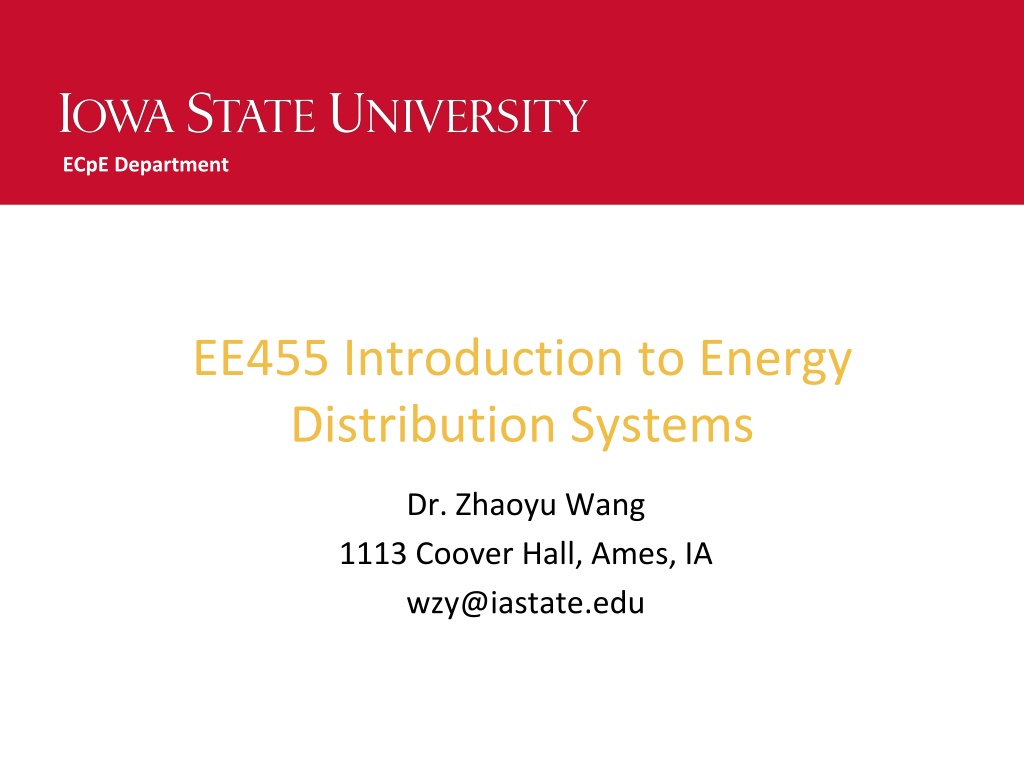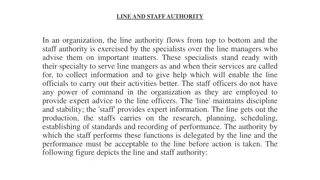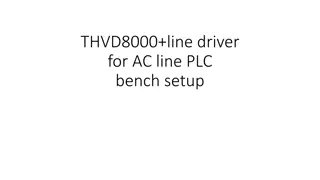Understanding Energy Distribution System Line Models
This presentation delves into the various line models used in energy distribution systems, including exact line segment models and their derivation from Kirchhoff's voltage and current laws. The discussion covers three line segment models, the computation of phase impedance and admittance matrices, and the development of equations to model overhead and underground line segments. Key concepts such as phase impedances and admittances are explained with references to practical applications.
Download Presentation

Please find below an Image/Link to download the presentation.
The content on the website is provided AS IS for your information and personal use only. It may not be sold, licensed, or shared on other websites without obtaining consent from the author. Download presentation by click this link. If you encounter any issues during the download, it is possible that the publisher has removed the file from their server.
E N D
Presentation Transcript
ECpE Department EE455 Introduction to Energy Distribution Systems Dr. Zhaoyu Wang 1113 Coover Hall, Ames, IA wzy@iastate.edu
Modeling Series Components Distribution Lines Acknowledgement: The slides are developed based in part on Distribution System Modeling and Analysis, 4th edition, William H. Kersting, CRC Press, 2017 2
Distribution System Line Models Overview Highlights of This Section: there are three line segment models Exact line segment model Modified line segment model (neglecting shunt admittance of exact model) 3 ECpE Department
Distribution System Line Models Overview Approximate line segment model (in sequence domain) In this section, we will study how to derive the above three models (from KVL and KCL), i.e., how to derive forward-backward sweep models. Here we will assume [Zabc] and [Yabc] are known. How to compute the phase impedance and phase admittance matrices using the actual phasing of the line and the correct spacing between conductors are discussed in modeling series impedance and shunt admittance. 4 ECpE Department
Exact Line Segment Model The exact model of a three-phase, two-phase, or single-phase overhead or underground line is shown in Fig.1. Fig.1 Three-phase line segment model 5 ECpE Department
Exact Line Segment Model When a line segment is two phase (V phase) or single phase, some of the impedance and values will be zero. Note that in all cases the phase impedance and phase admittance matrices were 3 3. Rows and columns of zeros for the missing phases represent two-phase and single-phase lines. Therefore, one set of equations can be developed to model all overhead and underground line segments. The values of the impedances and admittances in Fig.1 represent the total impedances and admittances for the line segment. That is, the phase impedance/admittance matrix has been multiplied by the length of the line segment. Fig.1 Three-phase line segment model 6 ECpE Department
Exact Line Segment Model For the line segment of Fig.1, the equations relating the input (node n) voltages and currents to the output (node m) voltages and currents are developed as follows. Kirchhoff's current law applied at node m is represented by ??? ??? ???? ?????? ?????? ?????? ?? ?? ?? ? ??? ??? ??? ??? ??? ??? ??? ??? ??? +1 (1) = 2 Fig.1 Three-phase line segment model 7 ECpE Department
Exact Line Segment Model ?????? ?????? ?????? ??? ??? ???? ?? ?? ?? ? ??? ??? ??? ??? ??? ??? ??? ??? ??? +1 (1) = 2 In condensed form Equation (1) becomes ???????? ?= ???? ?+1 (2) 2 ???? ?????? ? Kirchhoff's voltage law applied to the model gives ??? ??? ???? ??? ??? ???? ?????? ?????? ?????? ??? ??? ??? ??? ??? ??? ??? ??? ??? (3) = + In condensed form Equation (3) becomes (4) ?????? ?= ?????? ?+ ???? ???????? 8 ECpE Department
Exact Line Segment Model ???????? = ???? ?+1 (2) 2 ???? ?????? ? ?????? ?= ?????? ?+ ???? ???????? (4) Substituting Equation (2) into Equation (4), (5) ???? ?+1 ?????? ?= ?????? ?+ ???? 2 ???? ?????? ? Collecting terms, ?????? ?= [?] +1 ?????? ?+ ???? ???? ? (6) 2 ???? ???? where 1 0 0 0 1 0 0 0 1 (7) ? = Equation (6) is of the general form (8) ?????? ?=[?] ?????? ?+ ? ???? ? 9 ECpE Department
Exact Line Segment Model ?????? ?=[?] ?????? ?+ ? ???? ? (8) where ? = [?] +1 (9) 2 ???? ???? (10) ? = ???? The input current to the line segment at node n is ??? ??? ???? ?????? ?????? ?????? ?? ?? ?? ? ??? ??? ??? ??? ??? ??? ??? ??? ??? +1 = 2 (11) In condensed form, Equation (11) becomes +1 ???? ?= ???????? 2 ???? ?????? ? (12) 10 ECpE Department
Exact Line Segment Model ???????? = ???? ?+1 (2) 2 ???? ?????? ? +1 (12) ???? ?= ???????? 2 ???? ?????? ? Substitute Equation (2) into Equation (12): ???? ?= ???? ?+1 ?????? ?= [?] +1 2 ???? ?????? ?+1 2 ???? ?????? ? (13) ?????? ?+ ???? ???? ? (6) 2 ???? ???? Substitute Equation (6) into Equation (13): ???? ?= ???? ?+1 +1 2 ???? Collecting terms in Equation (14), ???? ?= ???? +1 (14) 2 ???? ?????? ? [?] +1 2 ???? ???? ?????? ?+ ???? ???? ? ?????? ?+ [?] +1 4 ???? ???? ???? 2 ???? ???? ???? ? (15) 11 ECpE Department
Exact Line Segment Model ???? ?= ???? +1 ?????? ?+ [?] +1 4 ???? ???? ???? 2 ???? ???? ???? ? (15) Equation (15) is of the form ???? ?=[?] ?????? ?+[?] ???? ? (16a) where ? = ???? +1 (17) Backward sweep equation 4 ???? ???? ???? ? = [?] +1 2 ???? ???? (18) (8) ?????? ?=[?] ?????? ?+ ? ???? ? Equations (8) and (16) can be put into partitioned matrix form: =[?] [?] [?] [?] ?????? ? ???? ? ?????? ? ???? ? (19) 12 ECpE Department
Exact Line Segment Model =[?] [?] [?] [?] ?????? ? ???? ? ?????? ? ???? ? (19) Equation (19) is very similar to the equation used in transmission line analysis when the A, B, C, D parameters have been defined [1]. In the case here the a, b, c, d parameters are 3 3 matrices rather than single variables and will be referred to as the generalized line matrices. Equation (19) can be turned around to solve for the voltages and currents at node m in terms of the voltages and currents at node n: 1 =[?] [?] [?] [?] ?????? ? ???? ? ?????? ? ???? ? (20) The inverse of the a, b, c, d matrix is simple because the determinant is (21) [?] ? [?] ? = ? [1] Glover, J.D. and Sarma, M., Power System Analysis and Design, 2nd edn., PWS Publishing Co., Boston, MA, 1995. 13 ECpE Department
Exact Line Segment Model 1 =[?] [?] [?] [?] ?????? ? ???? ? ?????? ? ???? ? (20) [?] ? [?] ? = ? (21) Using the relationship of Equation (21), Equation (20) becomes [?] [?] [?] [?] ?????? ? ???? ? ?????? ? ???? ? (22) = Since the matrix [a] is equal to the matrix [d], Equation (22) in expanded form becomes ?????? ?= ? ?????? ? ? ???? ? (23) (24) ???? ?= ? ?????? ?+ ? ???? ? 14 ECpE Department
Exact Line Segment Model (8) ?????? ?=[?] ?????? ?+ ? ???? ? Sometimes it is necessary to compute the voltages at node m as a function of the voltages at node n and the currents entering node m. This is useful in the ladder iterative technique, i.e., the forward sweep equation. Solving Equation (8) for the bus m voltages gives ?????? ?=[?] 1 ?????? ? ? ???? ? (25) Equation (25) is of the form (26) ?????? ?=[?] ?????? ? ? ???? ? (27) where ? = [?] 1 ? = [?] 1 ? (28) 15 ECpE Department
Exact Line Segment Model The line-to-line voltages are computed by ??? ??? ???? ??? ??? ??? ? 1 0 1 1 0 0 = = ? ?????? ? (29) 1 1 1 where 1 0 1 1 0 0 (30) ? = 1 1 1 Because the mutual coupling between phases on the line segments is not equal, there will be different values of voltage drop on each of the three phases. As a result the voltages on a distribution feeder become unbalanced even when the loads are balanced. A common method of describing the degree of unbalance is to use the National Electrical Manufactures Association (NEMA) definition of voltage unbalance as given in Equation (31) [2]. ??????? ????????? ???? ??????? ??????????= 100% ???????? [2] ANSI/NEMA Standard Publication No. MG1-1978, National Electrical Manufactures Association, Washington, DC. 16 ECpE Department
Example 1 A balanced three-phase load of 6000 kVA, 12.47 kV, 0.9 lagging power factor is being served at node m of a 10,000 ft three-phase line segment. The load voltages are rated and balanced 12.47 kV. The configuration and conductors of the line segment are those of Example 4.1. Determine the generalized line constant matrices [a], [b], [c], [d], [A], and [B]. Using the generalized matrices determine the line-to- ground voltages and line currents at the source end (node n) of the line segment. 17 ECpE Department
Example 1 Solution The phase impedance matrix and the shunt admittance matrix for the line segment are 0.4576 + ?1.0780 0.1560 + ?0.5017 0.1535 + ?0.3849 0.1560 + ?0.5017 0.4666 + ?1.0482 0.1580 + ?0.4236 ?5.6711 ?1.8362 ?0.7033 0.1535 + ?0.3849 0.1580 + ?0.4236 0.4615 + ?1.0651 ?1.8362 ?5.9774 ?1.1690 ???? [????] = ?0.7033 ?1.1690 ?5.3911 ???? = ? 376.9911 ???? = ?? ???? For the 10,000 ft line segment, the total phase impedance matrix and shunt admittance matrix are 0.8667 + ?2.0417 0.2955 + ?0.9502 0.2955 + ?0.9502 0.8837 + ?1.9852 0.2907 + ?0.7290 0.2992 + ?0.8023 0.2907 + ?0.7290 0.2992 + ?0.8023 0.8741 + ?2.0172 [????] = ?10.7409 ?3.4777 ?1.3322 ?3.4777 ?11.3208 ?2.2140 ?1.3322 ?2.2140 ?10.2104 ???? = ?? 18 ECpE Department
Example 1 It should be noted that the elements of the phase admittance matrix are very small. The generalized matrices computed according to Equations (9), (10), (17), and (18) are 1 0 0 0 1 0 0 0 1 ? = [?] +1 2 ???? ????= 0.8667 + ?2.0417 0.2955 + ?0.9502 0.2907 + ?0.7290 0.2955 + ?0.9502 0.8837 + ?1.9852 0.2992 + ?0.8023 0.2907 + ?0.7290 0.2992 + ?0.8023 0.8741 + ?2.0172 ? = [????] = 0 0 0 0 0 0 0 0 0 1 0 0 0 1 0 0 0 1 1 0 0 0 1 0 0 0 1 [c]= [d]= [A]= 0.8667 + ?2.0417 0.2955 + ?0.9502 0.2907 + ?0.7290 0.2955 + ?0.9502 0.8837 + ?1.9852 0.2992 + ?0.8023 0.2907 + ?0.7290 0.2992 + ?0.8023 0.8741 + ?2.0172 ? = [?] 1 ? = Because the elements of the phase admittance matrix are so small, the [a], [A], and [d] matrices appear to be the unity matrix. 19 ECpE Department
Example 1 If more significant figures are displayed, the 1,1 element of these matrices is ?1,1= ?1,1= 0.99999117 + ?0.00000395 Also, the elements of the [c] matrix appear to be zero. Again if more significant figures are displayed, the 1,1 term is ?1,1= 0.0000044134 + ?0.0000127144 The point here is that for all practical purposes the phase admittance matrix can be neglected. The magnitude of the line-to-ground voltage at the load is ??? =12470 = 7199.56 3 Selecting the phase a to ground voltage as reference, the line-to-ground voltage matrix at the load is ??? ??? ???? 7199.56 120 7199.56 0 7199.56 120 = V 20 ECpE Department
Example 1 The magnitude of the load current is 6000 3 12.47= 277.79 ??= For a 0.9 lagging power factor the load current matrix is 277.79 25.84 277.79 145.84 277.79 94.16 ???? ?= A The line-to-ground voltages at node n are computed to be 7538.70 1.57 7451.25 118.30 7485.11 121.93 ?????? ?=[a] ?????? ?+[b] ???? ?= V 21 ECpE Department
Example 1 It is important to note that the voltages at node n are unbalanced even though the voltages and currents at the load (node m) are perfectly balanced. This is a result of the unequal mutual coupling between phases. The degree of voltage unbalance is of concern since, for example, the operating characteristics of a three-phase induction motor are very sensitive to voltage unbalance. Using the NEMA definition for voltage unbalance (Equation (29)), the voltage unbalance is given by ????+ ????+ ???? 3 =7538.70+7451.25+7485.11 =7491.69 ???????? = 3 ?????????????= 7538.70 7491.69 = 47.01 47.01 7491.70 100%=0.6275% ??????????= Although this may not seem like a large unbalance, it does give an indication of how the unequal mutual coupling can generate an unbalance. It is important to know that NEMA standards require that induction motors be derated when the voltage unbalance exceeds 1.0%. 22 ECpE Department
Example 1 Selecting rated line-to-ground voltage as base (7199.56) the per-unit voltages at bus n are ??? ??? ???? 7485.11 121.93 By converting the voltages to per unit, it is easy to see that the voltage drop by phase is 4.71% for phase a, 3.50% for phase b, and 3.97% for phase c. The line currents at node n are computed to be 7538.70 1.57 7451.25 118.30 1.0471 1.57 1.0350 118.30 1.0397 121.93 1 = p.u. = 7199.56 277.71 25.83 277.73 148.82 277.73 94.17 ???? ?=[c] ?????? ?+[d] ???? ?= A Comparing the computed line currents at node n to the balanced load currents at node m, a very slight difference is noted that is another result of the unbalanced voltages at node n and the shunt admittance of the line segment. 23 ECpE Department
Modified Line Model It was demonstrated in Example 1 that the shunt admittance of an overhead line is so small that it can be neglected. Figure 2 shows the modified line segment model with the shunt admittance neglected. When the shunt admittance is neglected, the generalized matrices become (32) (33) (34) (35) (36) (37) ? = [?] ? = [????] ? = [0] ? = [?] ? = [?] ? = [????] 24 Fig.2 Modified line segment model ECpE Department
Three-Wire Delta Line If the line is a three-wire delta, then the voltage drops down the line must be in terms of the line- to-line voltages and line currents. However, it is possible to use equivalent line-to-neutral voltages so that the equations derived to this point will still apply. Writing the voltage drops in terms of line-to-line voltages results in ??????? ??????? ??????? ?????? ?????? ?????? ??? ??? ??? ? ??? ??? ??? ? (38a) + = where ?????? ?????? ?????? ?????? ?????? ?????? ??? ??? ??? ??? ??? ??? ??? ??? ??? (39) = ?????? ?????? ?????? ?????? ?????? ?????? ??? ??? ??? ? ??? ??? ??? ? (38b) + = 25 ECpE Department
Three-Wire Delta Line ?????? ?????? ?????? ?????? ?????? ?????? ??? ??? ??? ? ??? ??? ??? ? (38b) + = Expanding Equation (38b) for the phase a b, (40) ????= ????+?????? ?????? but (41) ????= ???? ???? ????= ???? ???? Substitute Equations (41) into Equation (40): ???? ????= ???? ????+ ?????? ?????? (42) Equation (42) can be broken into two parts in terms of equivalent line-to-neutral voltages: (43) ????= ????+ ?????? ????= ????+ ?????? The conclusion here is that it is possible to work with equivalent line-to-neutral voltages in a three-wire delta line. This is very important since it makes the development of general analyses techniques the same for four-wire wye and three-wire delta systems. 26 ECpE Department
Computation of Neutral and Ground Current The Kron reduction method was used to reduce the primitive impedance matrix to the 3 3 phase impedance matrix. Fig.3 shows a three-phase line with grounded neutral that is used in the Kron reduction. Note that the direction of the current flowing in the ground is shown in Fig.3. Fig.3 Three-phase line with neutral and ground currents (Note the main differences between this figure and the modified line mode in Fig.2: (1) the impedances here are primitive impedances and neutral conductor is in the figure and (2) the impedances in Fig. 2 are phase impedances that have already considered neutral conductor effect ) 27 ECpE Department
Computation of Neutral and Ground Current In the development of the Kron reduction method, Equation (44) defined the neutral transform matrix [tn]. ?? = ??? 1 ??? (44) The matrices ??? and ???are the partitioned matrices in the primitive impedance matrix. When the currents flowing in the lines have been determined, Equation (45) is used to compute the current flowing in the grounded neutral wire(s): (45) ?? = ?? ???? In Equation (45), the matrix ??for an overhead line with one neutral wire will be a single element. However, in the case of an underground line consisting of concentric neutral cables or taped shielded cables with or without a separate neutral wire, ?? will be the currents flowing in each of the cable neutrals and the separate neutral wire if present. Once the neutral current(s) has been determined, Kirchhoff's current law is used to compute the current flowing in ground: ??= (??+ ??+ ??+ ??1+ ??2+ + ???) (46) 28 ECpE Department
Example 2 The line of Example 1 will be used to supply an unbalanced load at node m. Assume that the voltages at the source end (node n) are balanced three phase at 12.47 kV line to line. The balanced line-to-ground voltages are 7199.56 0 7199.56 120 7199.56 120 V ?????? ?= The unbalanced currents measured at the source end are given by ?? ?? ?? ? 249.97 24.5 277.56 145.8 305.54 95.2 = A Determine The line-to-ground and line-to-line voltages at the load end (node m) using the modified line model The voltage unbalance The complex powers of the load The currents flowing in the neutral wire and ground 29 ECpE Department
Example 2 Solution The [A] and [B] matrices for the modified line model are 1 0 0 0 1 0 0 0 1 ? = [?]= 0.8667 + ?2.0417 0.2955 + ?0.9502 0.2907 + ?0.7290 0.2955 + ?0.9502 0.8837 + ?1.9852 0.2992 + ?0.8023 0.2907 + ?0.7290 0.2992 + ?0.8023 0.8741 + ?2.0172 ? = [????] = Since this is the modified line model, [Iabc]m is equal to [Iabc]n. Therefore ?? ?? ?? ? The line-to-ground voltages at the load end are 249.97 24.5 277.56 145.8 305.54 95.2 = A 6942.53 1.47 6918.35 121.55 6887.71 117.31 V ?????? ?= ? ?????? ? [?] ???? ?= 30 ECpE Department
Example 2 The line-to-line voltage at the load end are 1 0 1 1 0 0 ? = 1 1 1 12,008 28.4 12,025 92.2 11,903 148.1 V ?????? ?= ? ?????? ?= For this condition, the average load voltage is ???????? =6942.53+6918.35+6887.71 =6916.20 3 The maximum deviation from the average is on phase c so that ??????????????= 6887.71 6916.20 =28.49 28.49 6916.20 100% =0.4119% ??????????= 31 ECpE Department
Example 2 The complex powers of the load are ??? ?? ??? ?? ??? ?? 1597.2 + ?678.8 1750.8 + ?788.7 1949.7 + ?792.0 ?? ?? ?? 1 = 1000 = ?? + ????? The neutral transformation matrix from Example 4.1 is [?? ]= 0.4292 ?0.1291 0.4476 ?0.1373 0.4373 ?0.1327 The neutral current is [?? ]= [?? ] ???? ?= 26.2 29.5 The ground current is ??= (??+ ??+ ??+ ??) = 32.5 77.6 32 ECpE Department
Approximate Line Segment Model The approximate line model can be developed by applying the reverse impedance transformation from symmetrical component theory. Using the known positive and zero sequence impedances, the sequence impedance matrix is given by (See Chapter 4, Kersting) ?0 0 0 0 0 0 ?+ 0 (47) [????] = ?+ Note that this assumption means lines are assumed to be transposed, that is why this model is called approximate model. The reverse impedance transformation results in the following approximate phase impedance matrix: [???????] = [??] [????] [??] 1 (48) (2?++?0) (?0 ?+) (?0 ?+) (?0 ?+) (2?++?0) (?0 ?+) (?0 ?+) (?0 ?+) (2?++?0) [???????] =1 3 (49) 33 ECpE Department
Approximate Line Segment Model Notice that the approximate impedance matrix is characterized by the three diagonal terms being equal and all mutual terms being equal. This is the same result that is achieved if the line is assumed to be transposed. Applying the approximate impedance matrix the voltage at node n is computed to be ??? ??? ???? ??? ??? ???? (2?++?0) (?0 ?+) (?0 ?+) (?0 ?+) (2?++?0) (?0 ?+) (?0 ?+) (?0 ?+) (2?++?0) ?? ?? ?? ? (50) +1 = 3 In condensed form, Equation (50) becomes ?????? ?= ?????? ?+ [???????] ???? ? (51) Note that Equation (51) is of the form ?????? ?= [?] ?????? ?+[?] ???? ? (52) where ? = ????? ?????? ? = [???????] 34 ECpE Department
Approximate Line Segment Model ??? ??? ???? ??? ??? ???? (2?++?0) (?0 ?+) (?0 ?+) (?0 ?+) (2?++?0) (?0 ?+) (?0 ?+) (?0 ?+) (2?++?0) ?? ?? ?? ? +1 = 3 (50) Equation (50) can be expanded and an equivalent circuit for the approximate line segment model can be developed. Solving Equation (50) for the phase a voltage at node n results in ????= ????+1 (53) 3 (2?++?0)??+ (?0 ?+)??+ (?0+?+)?? Modify Equation (53) by adding and subtracting the term (Z0 Z+)Ia and then combining terms and simplifying: (2?++?0)??+ (?0 ?+)??+ (?0+?+)?? +(?0 ?+)?? (?0 ?+)?? 3 (3?+)??+ (?0 ?+)(??+ ??+ ??) (??+ ??+ ??) ????= ????+1 = ????+1 = ????+?+ ??+(?0 ?+) 3 (54) 3 35 ECpE Department
Approximate Line Segment Model The same process can be followed in expanding Equation (50) for phases b and c. The final results are ????= ????+?+ ??+(?0 ?+) (55) (??+ ??+ ??) 3 ????= ????+?+ ??+(?0 ?+) (56) (??+ ??+ ??) 3 Fig.4 illustrates the approximate line segment model. Fig.4 Approximate line segment model Fig.4 shows a simple equivalent circuit for the line segment since no mutual coupling has to be modeled. It must be understood, however, that the equivalent circuit can only be used when transposition of the line segment has been assumed. 36 ECpE Department
Example 3 The line segment of Example 1 is to be analyzed assuming that the line has been transposed. In Example 1, the positive and zero sequence impedances were computed to be ?+=0.3061 +?0.6270,?0= 0.7735 + ?1.9373 Assume that the load at node m is the same as in Example 6.1. That is, ??? =6000,???? = 12.47, Power factor =0.8 lagging Determine the voltages and currents at the source end (node n) for this loading condition. 37 ECpE Department
Example3 Solution The sequence impedance matrix is 0.7735 + ?1.9373 0 0 0 0 0 /???? 0.3061 + ?0.6270 0 [???] = 0.3061 + ?0.6270 Performing the reverse impedance transformation results in the approximate phase impedance matrix: [???????] = [??] [????] ?? 0.4619 + ?1.0638 0.1558 + ?0.4368 0.1558 + ?0.4368 0.4619 + ?1.0638 0.1558 + ?0.4368 0.1558 + ?0.4368 1 0.1558 + ?0.4368 0.1558 + ?0.4368 0.4619 + ?1.0638 /???? = For the 10,000 ft line, the phase impedance matrix and the [b] matrix are ? = ??????? 10000 5280 0.2951 + ?0.8272 0.2951 + ?0.8272 0.8748 + ?2.0147 0.8748 + ?2.0147 0.2951 + ?0.8272 0.2951 + ?0.8272 0.2951 + ?0.8272 0.8748 + ?2.0147 0.2951 + ?0.8272 /???? = 38 ECpE Department
Example 3 Note in the approximate phase impedance matrix that the three diagonal terms are equal and all of the mutual terms are equal. Again, this is an indication of the transposition assumption. From Example 1, the voltages and currents at node m are 7199.56 0 7199.56 120 7199.56 120 V ?????? ?= ?? ?? ?? ? 277.79 25.84 277.79 145.84 277.79 94.16 = A Using Equation (52), 7491.72 1.73 7491.72 118.27 7491.72 121.73 V ?????? ?= [?] ?????? ?+[?] ???? ?= 39 ECpE Department
Example 3 Note that the computed voltages are balanced. In Example 1, it was shown that when the line is modeled accurately, there is a voltage unbalance of 0.6275%. It should also be noted that the average value of the voltages at node n in Example 6.1 was 7491.69 V. The Vag at node n can also be computed using Equation (54): ????= ????+?+ ??+(?0 ?+) (??+ ??+ ??) 3 Since the currents are balanced, this equation reduces to ????= ????+?+ ?? = 7199.56 0 + 0.5797 + ?1.1875 277.79 25.84 = 7491.72 1.73 V It can be noted that when the loads are balanced and transposition has been assumed, the three-phase line can be analyzed as a simple single-phase equivalent as was done in the calculation earlier. 40 ECpE Department
Example 4 Use the balanced voltages and unbalanced currents at node n in Example 2 and the approximate line model to compute the voltages and currents at node m. Solution From Example 6.2, the voltages and currents at node n are given as 7199.56 0 7199.56 120 7199.56 120 V ?????? ?= ?? ?? ?? ? 249.97 24.5 277.56 145.8 305.54 95.2 = A The [A] and [B] matrices for the approximate line model are ? = ????? ?????? ? = [???????] 41 ECpE Department
Example 4 The voltages at node m are determined by 6993.10 1.63 6881.15 121.61 6880.23 117.50 V ?????? ?= [?] ?????? ? [?] ???? ?= The voltage unbalance for this case is computed by ????????=6993.10+6881.15+6880.23 =6918.16 3 ??????????????= 6993.12 6918.17 =74.94 74.94 6918.17 100% =1.0833% ??????????= Note that the approximate model has led to a higher voltage unbalance than the exact model. 42 ECpE Department
Distribution System Line Models The modeling of distribution overhead and underground line segments is a critical step in the analysis of a distribution feeder. The phase impedance and admittance matrices are needed to build line models. ( and ) [????] [????] How to compute the phase impedance and phase admittance matrices using the actual phasing of the line and the correct spacing between conductors? 43 ECpE Department
Thank You! 44 ECpE Department























